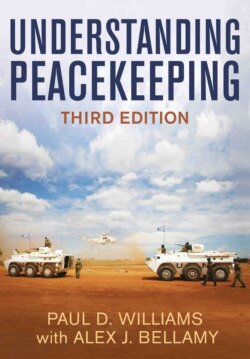Читать книгу Understanding Peacekeeping - Alex J. Bellamy - Страница 47
4 Peace Operations during the 1990s
ОглавлениеBetween 1988 and 1993, peace operations underwent a triple transformation. First, there was a quantitative transformation. During this period, the UN conducted twenty-two peace operations – more than it had undertaken in its previous forty years combined. The number of non-UN peace operations also rose significantly, although not to the same degree (with twelve missions launched during this period compared with twenty-seven between 1947 and 1987). There was also one UN-authorized mission: the US-led Unified Task Force deployed to Somalia in 1992. As a result, the number of countries providing peacekeepers also increased, including great powers such as the US, France and the UK (Findlay 1996). Second, there was a normative transformation reflected in the move to promoting a post-Westphalian conception of stable peace. Finally, as a result of the normative transformation, there was a qualitative transformation of UN operations, which were asked to carry out complex missions reminiscent of ONUC in the 1960s but on a far more regular basis. In places such as Cambodia, Bosnia and Somalia, the UN launched operations that were qualitatively different from earlier missions, marrying peacekeeping with the delivery of humanitarian aid, state-building programmes, local peacemaking and elements of peace enforcement. With the important exception of ONUC, these missions were also much larger and more expensive than anything the UN had attempted before. In contrast, most non-UN peace operations during this period remained focused on more traditional tasks.
By 1995, however, the catastrophes in Angola, Somalia, Bosnia and Rwanda prompted many states to re-evaluate the value of UN peace operations and the nature of their contribution to them. Some senior UN officials also asked whether the organization should go ‘back to basics’ and conduct operations only with the consent of the host parties (Tharoor 1995). The number of UN peacekeepers then fell dramatically, and regional organizations and coalitions became more popular. This ushered in a period of introspection at the UN, during which the organization produced important reports detailing its failings in Rwanda and Bosnia and a comprehensive review conducted by the so-called Brahimi panel (UN 2000). These reports identified serious problems with the way in which the UN mandated, organized and conducted its peace operations and exposed gaps between the tasks peacekeepers were expected to fulfil and the conceptual and material resources made available to them.
The end of the twentieth century was therefore a seminal time for peace operations, which this chapter explores in four parts. The first two sections examine the causes and the nature of the triple transformation of peace operations, while the third focuses briefly on some of the high-profile missions, charts the failure of operations in Somalia, Angola, Bosnia and Rwanda, and describes the subsequent retreat from UN peace operations. The final section examines what lessons were learned from these failures, especially the 1994 Rwandan genocide and the 1995 massacre in the Bosnian ‘safe area’ of Srebrenica.
